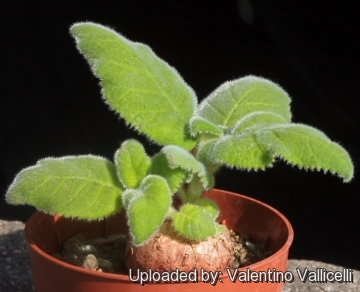Accepted Scientific Name: Sinningia cardinalis (Lehm.) H.E.Moore
Baileya 19: 39 1973

Gesneria cardinalis (Sinningia cardinalis) Photo by: Sándor Horváth
Origin and Habitat: Brazil, Rio de Janeiro.
Synonyms:
See all synonyms of Sinningia cardinalis
back
Accepted name in llifle Database:Sinningia cardinalis (Lehm.) H.E.MooreBaileya 19: 39 1973Synonymy: 9
back
Common Names include:
ENGLISH: Cardinal Flower, Gloxinia, Brazilian Gloxinia
Description: It is a compact plant with green velvety leaves and a silvery hair-covering on whole parts. It grows from tubers and has a period of dormancy after growth and flowering. This species can grow fairly large, with many brilliant red hooded flowers produced at one time
Tuber (Caudex): Rounded often depressed-globose, 6 (or more) cm in diameter with light brown bark. Seedling forms a tuber at the base of the stem very early in its development. When the tuber first forms, it is green, and only turns brown as it develops.
Stems: Ascending less than 30 cm tall from the tuber, pale green and tomentose.
Leaves: About 4-5 pairs per stem, decussate, broad, ovate to heart-shaped up 5-20 cm long and 4-15 cm wide, upper face apple-green to emerald-green with dark green about the veins, lower face paler, soft velvety, covered with dense short silvery hairys, margin crenate. Petioles 1-6 cm long green or reddish.
Flowers: One to several in terminal clusters on short peduncles in axils of upper leaves, about 5 cm long tubular, bright red, calyx lobes reflexed at the apex with the upper two corolla lobes prominently extended and much longer than the lower three lobes, presumably to assist in transfer of pollen to the head of the hummingbird and corolla tube laterally compressed. Pedicel 2-5 cm long with red hair-covering. Filaments up to 6 cm long, red and hairy-velvety, anthers coherent in a disc, style up to 6 cm long pinkish slightly exserted.
Blooming season. Flowers several times a year mainly in late summer and autumn.
Fruit: Ovoidal capsules with persistent style.
Bibliography: Major references and further lectures
1) Chautems, A. 1991. “Taxonomic revision of Sinningia Nees (Gesneriaceae) II. New species from Brazil.” Candollea 46:411-425
2) Maxwell. H.S. 2000. “Sinningia. in European Garden Flora” 6: 378-379.
3) Moore, H.E. 1973. “Comments of cultivated Gesneriaceae.” Baileya 19: 35-41.
4) A. B. Graf “Tropica: Color Cyclopedia of Exotic Plants and Trees from the Tropics and Subtropics” Roehrs, 1978
5) Fritz Encke, Alfred Fessler “Kalt- und Warmhauspflanzen: Arten, Herkunft, Pflege und Vermehrung : ein Handbuch für Liebhaber und Fachleute” Eugen Ulmer, 1987
6) James Cullen, Sabina G. Knees, H. Suzanne Cubey “The European Garden Flora Flowering Plants: A Manual for the Identification of Plants Cultivated in Europe, Both Out-of-Doors and Under Glass” Cambridge University Press, 11/Aug/2011
7) D. J. Mabberley “Mabberley's Plant-book: A Portable Dictionary of Plants, Their Classifications, and Uses” Cambridge University Press, 01/May/2008
 Gesneria cardinalis (Sinningia cardinalis) Photo by: Valentino Vallicelli
Gesneria cardinalis (Sinningia cardinalis) Photo by: Valentino Vallicelli Gesneria cardinalis (Sinningia cardinalis) Photo by: Sándor Horváth
Gesneria cardinalis (Sinningia cardinalis) Photo by: Sándor HorváthCultivation and Propagation: Sinningia cardinalisSN|22905]]SN|22905]] has a dormant period after flowering (winter rest) and comes into growth in early spring. After a period of dormancy the tuber will send up new growth and the cycle will repeat. Some cultivars can be induced to remain in almost perpetual growth, with no period of full dormancy. Others may go dormant, and never "break dormancy", or begin new growth. But most plants will produce new and better growth after a period of dormant inactivity.
Soil: Use a lime free soil that retains water yet drains well with a little added pumice will suffice.
Pots: Always use a pot with a hole and provide a good drainage.
Watering: Drench the soil and let it become moderately dry between waterings when it is in growth and during the winter or dormant season must be kept very much on the dry side. Perpetually wet soil may result in rotting of the tuber, while dry conditions will usually induce premature dormancy.
Fertilization:: Needa a regular light fertilization during growing season including all micro nutrients and trace elements or slow release fertilizer at the rate of 1/4 the dose indicated in the label. However some of the more robust cultivars will respond favourably to a more concentrated solution, and some of the smaller cultivars need very little feeding.
Exposures: It requires bright conditions, but not sun and can be grown eventually under bright fluorescent lights or in a greenhouse and many tolerate windowsill conditions if humidity can be kept up and bright light provided without too much direct sun.
Pest & diseases: Prone to mealy bugs. Always inspect any new plant for pests before introducing it to your home or greenhouse.












